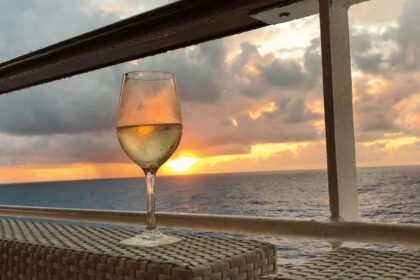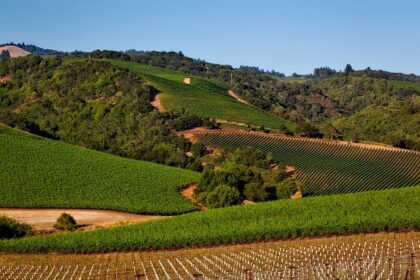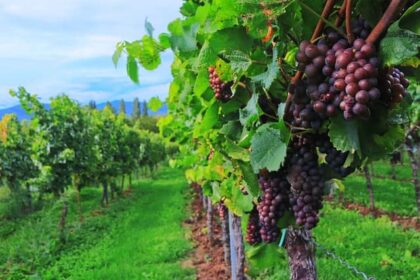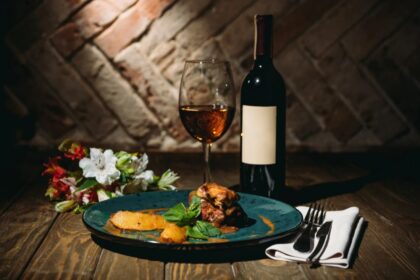Many pleasant surprises await those who first visit Oregon’s northern Willamette Valley, best known as the epicenter of Oregon Pinot Noir. There is breathtaking scenery, a temperate climate, and frequent opportunities for visitors to interact with winery owners and winemakers. You’ll be amazed at the many different ways to travel – by car, by limousine, by bicycle, on horseback. And above all, you will discover great wines other than Pinot Noir.
The number of wineries in the Willamette Valley – approximately 200 and counting – means that every trip you take will be unique. The sheer variety of wines represented proves that Oregon is not a gimmick wine pony. In many tasting rooms, you’ll find laser-sharp Pinot Blancs, juicy Pinot Gris, smooth and bright Chardonnays and bright, aromatic Rieslings. Elsewhere, you’ll find more exotic specialties like Arnais, Auxerrois, Gamet Noir, Müller-Turgau, and Zinfandel.
Tourism has become a top priority for many wineries as Oregon faces its first significant wine surplus in years. For consumers, this means lower prices, even on top-notch wines, and higher-quality Oregon wines are selling for $15 or less. It also means you’ll feel welcome wherever you go. With a little advance planning, the chances of a “behind the scenes” tour, perhaps with a winemaker, are great.
The purpose of this article is to help with your pre-planning. Not to tell you exactly where to go, but to offer some tips on how to make the most of your time, and to look at some interesting places to stop and dine.
Day One – Portland
Start in downtown Portland, which is full of great wine tastings and fine restaurants. I checked in at the friendly Ace Hotel. The hand-knotted monogram displayed in the elevator perfectly captures the gestalt of the place. Possessing a great attitude, the carelessly fashionable Ace becomes the perfect Portland headquarters. Stumptown Coffee and Clyde Common are on-site, and the Pearl District, the epicenter of downtown food and drink, is right outside the front door.
Within walking distance are Powell’s books, several museums, and some great wine bars. Try Bottle Metrovino Bistro Bar for both New American cuisine and extensive wine flights Oregon Wines on Broadway for an intimate setting and regional accent or Thirst Wine Bar and Bistro for great views.
In recent years, Portland has become the base for a growing number of craft distillers, especially Clear Creek , the first and largest, as well as several wineries such as Portland Wine Project, home to Boedecker Wine Cellars and Grochau Wines. You may be sorry to leave town so soon, but the Willamette Valley and its wineries beckon, the nearest being just 40 minutes southeast of town.
A few general tips: group visits to wineries to cut down on driving time. Unlike Napa, where the two main roads run north-south and are easy to navigate, here in Oregon, you’ll find yourself on winding, hilly country roads as soon as you get off the highway. Traveling seemingly short distances takes up a lot of your time and energy. Of course, you’ll drink lots of water, force yourself to spit (that’s really normal for wineries) and, whenever possible, hire a dedicated driver.
According to Sue Horstmann, executive director of the Willamette Valley Winery Association, the busiest tourist times begin with Valentine’s Day weekend and continue through Thanksgiving. On those two holidays, along with Memorial Day, Labor Day and IPNC weekend, almost all tasting rooms are open and special events are planned. But if you prefer to come to town when it’s not crowded, avoid the holidays and summer weekends. For a quieter, more intimate vacation, the beginning or middle of the week is best.
Day 2 – Chehalem Mountains, AVA
Just 19 miles southwest of downtown Portland is the Chehalem Mountains (sha-hay-lum), AVA. There are about 1,600 acres of vineyards here, including early plantings by pioneers Dick Erath, David Adelsheim and Dick Ponzi.
Rex Hill, now also home to a winery from A to Z. Rex Hill was one of Oregon’s first wineries to bottle Pinot Noir from individual vineyards. Production has dropped from 30,000 cases to 10,000 cases, and quality is on the rise again. Five or six wines are bottled ($10 fee, free for wine club members). In the center of the room is an interesting “essences table,” with a couple dozen Riedel glasses lined up in a circle, each holding a different herb, flower, spice, fruit or other aromatic component. A sniffer’s paradise.
J. K. Carrie . The brand was launched in 1999 by Jim and Allison Prosser, but the winery is new, as is the adjoining vineyard atop Mount Parrott. The goal is “high-acid, smooth tannins, mature pinots,” exemplified by their bottling of Provocateur ($24). “We intend to make wines that get better within the first five years,” says Jim Prosser, who has made wine in Burgundy and New Zealand and the Willamette Valley.
The day was spent touring wineries on Calkins Lane, a short drive west of Newberg. It started at Adelsheim Vineyard , founded in 1971 by David and Jeannie Adelsheim. Here, up to a dozen wines from a single vineyard are poured for visitors to the tasting room. Wine club members taste wine for free, and special tastings from the library can be arranged upon advance request.
Just down the road is The Gazebo , a charming former walnut and hazelnut farm that now includes a 12-acre vineyard, a tasting room in a century-old walnut drying barn and crate storage in the owners’ former horse pens. It’s the fruit of Dave and Mary Hansen’s love, making selections of Pinot and gorgeous late-harvest Sidney Semillon.
Within shouting distance is Lachini, another relatively new Pinot store with 45 acres and an outdoor patio with one of the best views in the area. The new tasting room is under construction and should open this summer, check the website for special events in the meantime.
Trisaetum was the next stop. It is a unique winery/art gallery showcasing the exceptional talents of owner James Frey. Located near Beau Frere and Brickhouse in the AVA Ribbon Range (a subset of the Chehalem Mountains), Trisaetum is a must-see. Frey is a photojournalist and artist, and his breathtaking work is on display and for sale next to the winery’s tasting room. Check out the “Fermentation” series – paintings that use real grape dirt – and the “Element” series, which uses real grapevine cuttings on canvas.
The winery, co-designed by neighbor Josh Bergstrom, includes such useful devices as a fruit vacuum to prevent insects and other MOG (material other than grapes) from entering the fermenters. Frey and his wife are devoted lovers of Riesling and Pinot Noir. “We will do everything in our power to produce one of the best Rieslings in America,” he states frankly.
The first Trisaetum Rieslings are truly exceptional. In 2007, aromas of beeswax and gasoline already appear, while retaining the honey-floral character of the young fruit. The 2008 Botrytized Riesling Lassa (9% alcohol and 13% residual sugar) is a revelation with exotic aromas of plumeria and fleurdorange, a thick blend of fruit and even a streak of mint.
At the end of this first day, there was still time to visit the newly opened Newberg tasting room for Chehalem. “We make wines from the varieties we like to drink ourselves if we can’t sell them,” joked Harry Peterson-Nedry of Chehalem as he poured a glass of his light, spicy, estate-grown Grüner Veltliner.
Day 3 – Dundee Hills, AVA
The Dundee Hills AVA Hotel occupies the heart (and soul) of the north Willamette Valley. It was here that David Lett, who founded Eyrie Vi neyards, planted the region’s first Vinifera grape varieties. The Red Hills, as they are affectionately known, are now home to 1,700 acres of vineyards and some of Oregon’s most legendary wineries, including Domaine Drouhin, Domaine Serene, Erath, the Eyrie Vineyards and Sokol Blosser.
Before heading into the hills, stop in nearby Carlton, a hive of winemaking activity. Ken Wright was the first to move into town, occupying an abandoned glove factory. Today there are a dozen tasting rooms on the block downtown, about three dozen in the city limits and many more nearby.
At the Carlton Winemakers Studio My guide was founder Eric Hamacher. Current residents include Andrew Rich, Ayoub, Brittan , Lazy River Vineyard , Montebruno , Return, Good Vineyards and his own Hamacher Winery .
Since the studio opened eight years ago, there have been 19-20 tenants, including such iconic boutiques as Soter, Scott Paul, Penner Ash and Kelly Fox. “It’s like a really exclusive bottle store that works on behalf of each winery,” Hamacher explained.
The Studio tasting room offers up to 40 different wines by the glass or in small flights. On some Saturdays, visiting winemakers hold seminars on AVA, clone breeding, cooperage and other interesting topics. The first success was “Soup Night” with guest chefs, family sit-ins and climbing lessons. “The tail wags the dog,” Hamacher says. “It caused a stir, but not bottle sales.”
The rest of the day was devoted to the Red Hills. At Falcon Blosser , a leader in organic farming and “green” business practices, sales manager Michael Brown explained that “the Oregon traveler expects more and more these days. I want to get away from the idea of staff standing behind the counter pouring wine. I want to invite people over for a tasting. Every weekend we do vineyard hikes, a five-hour, three-mile loop with two leaders and lunch in the vineyard.”
Vista Hills occupies such an impressive location that their wine club is called the Treehouse Club. Next door are Domaine Drouhin, Domaine Serene and Archery Summit. Three dozen weddings a year are held here. Want to come to your wedding in a horse-drawn carriage or take a trip through the vineyards on horseback? Equestrian Wine Tours can oblige.
Nearly 25 years ago, Robert Drouhin gained international attention and instant credibility in the region when he founded Domaine Drouhin, Oregon . This famous winery is now open to the public and is one of the few that can offer visitors individual tastings of Burgundy and Oregon Pinots. The day of my visit was Philip Drouin, brother of winemaker Veronique Drouin. He is responsible for managing vineyards on both sides of the Atlantic.
Domaine Serene. Here the basic tasting costs $15, but for $40 (by appointment only) you get a VIP seat. tour and tasting, with paired wines from the same vineyard and cheeses. Plans are in the works for an even more ambitious option, including a vineyard tour, an extended tasting and “a more epicurean experience,” says public relations manager Michelle Boyer. Domaine Serene’s large selection of wines includes a half-dozen pinots highlighted by the Evenstad Reserve.
Tastings, vineyard walks and scenic drives can last for days or even weeks. To make the most of your time in the valley, be sure to visit some of the restaurants and wine bars featured here, and they all specialize in local releases that are hard to find. It’s that taste of wine that can be felt within a few miles or even yards of where its fruit is grown, which is what makes a wine tour so special and memorable.




